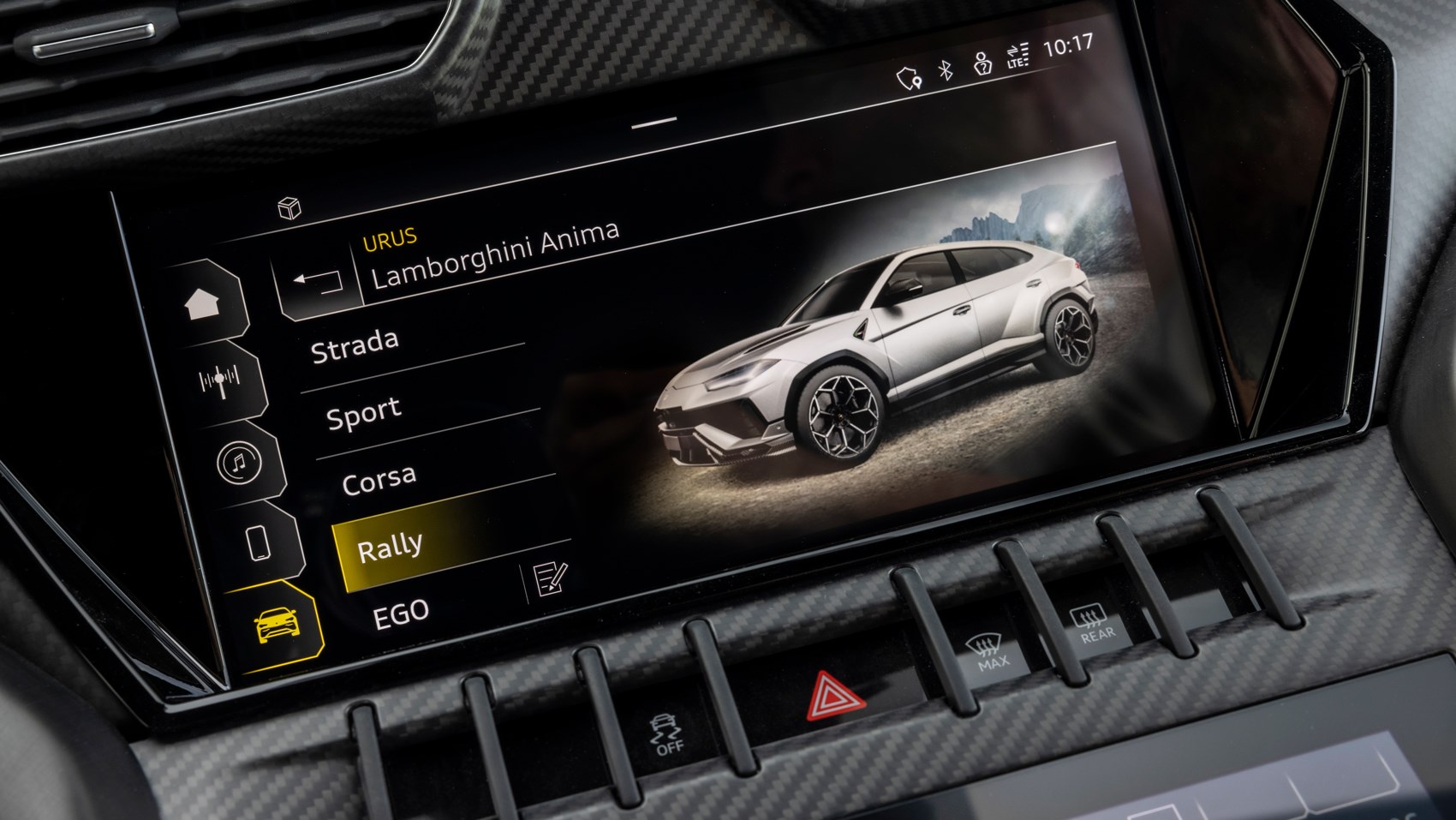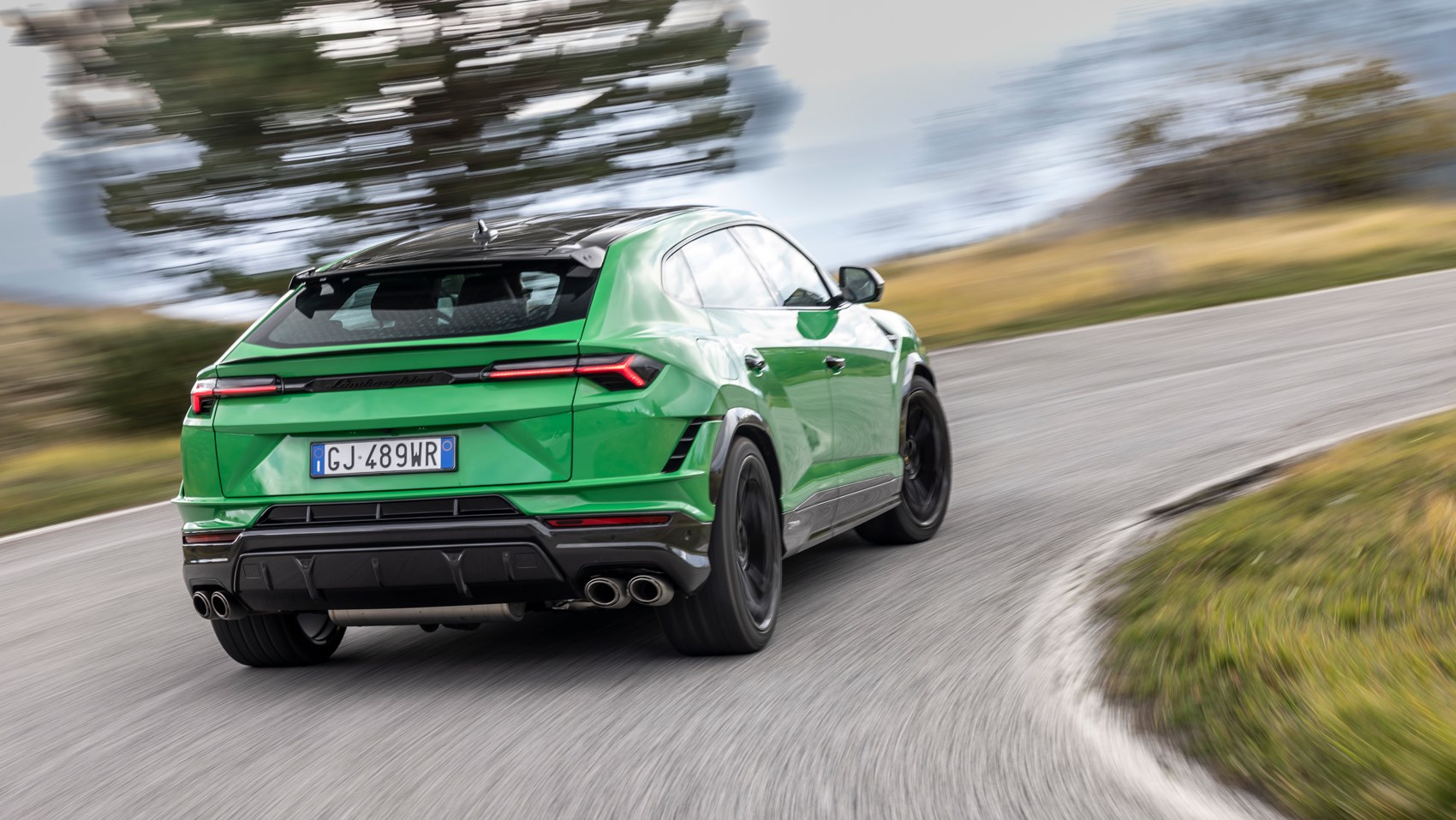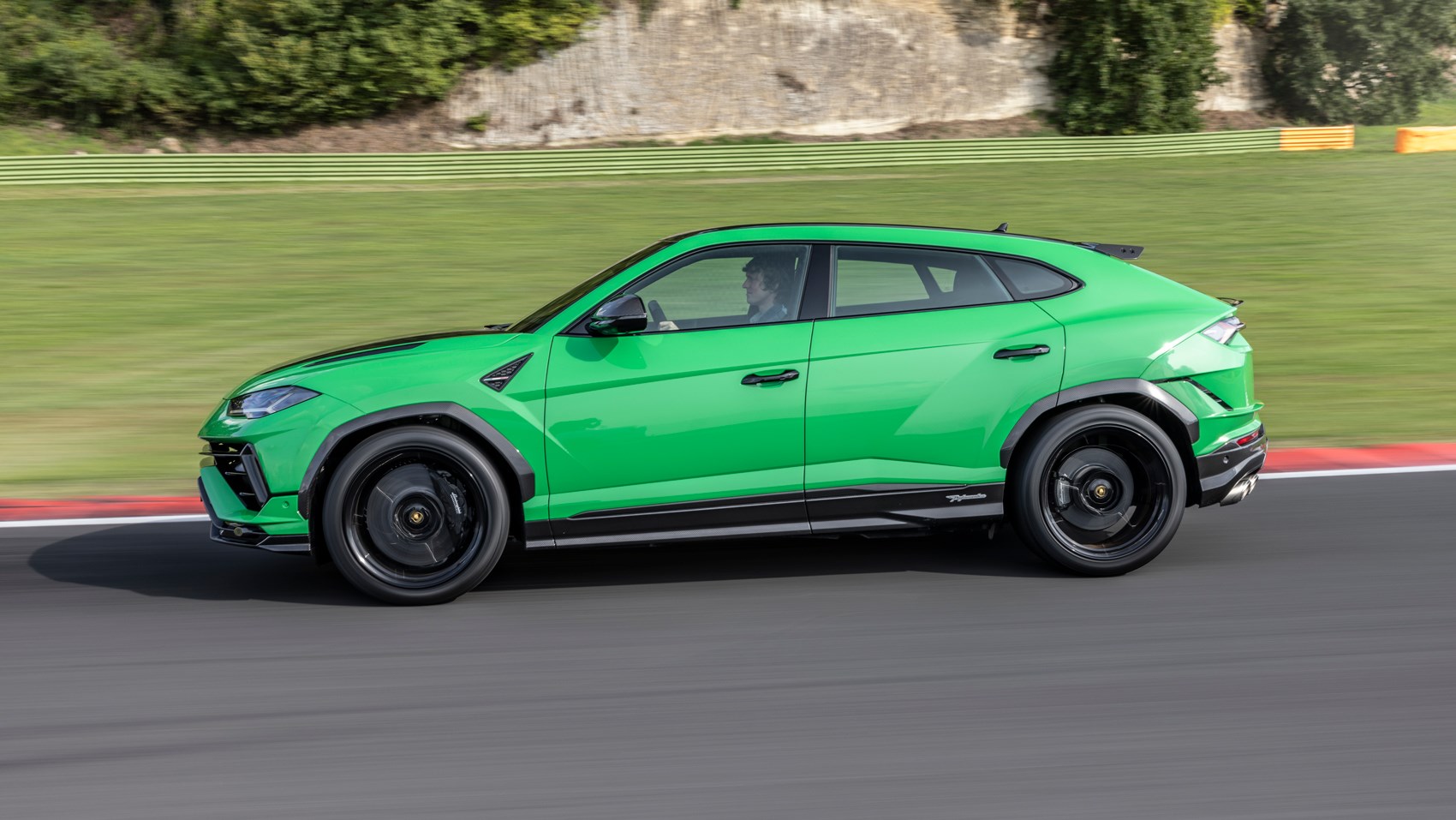► New super-Urus tested on track and off-road
► 657bhp, 627lb ft, 3.3sec 0-62mph, £209,000
► Steel-sprung suspension and ‘Rally mode’
The Lamborghini Urus is already towards the superest end of the super-SUV scale, with 641bhp and a top speed of 190mph. There’s always headroom, and demand, for something quicker, however: meet the Lamborghini Urus Performante.
Numerous upgrades across drivetrain, suspension and aero (and price). There are also recalibrated drive modes (plus a new Rally mode), and interior and exterior design alterations. It’s a little lighter than the regular car, too.
The Performante is not to be confused with the also-new Lamborghini Urus S, by the way; that’s the recently revealed evolution of the standard Urus which will enter production soon and become the new base-model Urus (although it will feature the same 657bhp engine as the Performante). You can read more about that car here.

Here’s an overview of the Performante’s principal upgrades:
Price
The Lamborghini Urus Performante costs approximately £209,000 on the road in the UK, versus £188,000 for the Urus S (and £165k for the original standard Urus).
Power
Compared with the original Urus, the 4.0-litre twin-turbo V8 has been mapped to 657bhp (or an Ol’ Nick business-card-worthy 666 metric horsepower) versus the original Urus’s 641bhp. Torque remains at a hefty 627lb ft. The power increase comes from software adjustments rather than mechanical changes, although there’s a small amount of benefit from the new titanium exhaust system too.
Suspension and steering
Biggest change is the adoption of steel springs in place of the normal Urus’s air suspension. The Performante still has adaptive dampers, which have been recalibrated in conjunction with the new springs. It sits 20mm lower than the regular car on 16mm wider tracks.
The rear-wheel steering has been reprogrammed too, for more agile turn-in.
Drive modes
The familiar Strada, Sport and Corsa modes have been recalibrated to suit the altered suspension and there’s also a new Performante-specific mode: the rousingly named Rally mode.

That allows more wheelspin from the traction control and angle from the stability control systems, and softens the dampers to make the most of weight transfer to slide the car in a controlled manner on loose surfaces.
It’s not a rear-drive-override ‘drift mode’ as per some other cars; the Urus Performante still has a permanent four-wheel drive system with a Torsen centre differential and torque vectoring on the rear differential (with additional planetary gears with clutches either side of the differential, to influence the direction of the torque), plus a small amount of vectoring by braking on top.
Interior
It’s a festival of alcantara, with most surfaces lined in the tactile, anti-glare suede-like material. There’s more use of black trim than in the normal Urus, with various interior trim pieces finished in matt black and anodised black. Carbonfibre is used extensively across the interior trim pieces, too.
Exterior
Plenty of carbonfibre on the outside as well. The bonnet, arches, spoilers and, optionally, the roof are all made from carbonfibre. Cumulatively, they contribute to more than seven kilos of weight-saving.
Cooling for both engine and brakes is improved over the regular Urus, and aerodynamics has also been a focus. A revised air curtain designed into the front bumper tidies airflow around the front wheels, and is styled to make the already steroidal Urus look even butcher. Longitudinal vents sliced into the bonnet help extract hot air and a tailgate spoiler significantly cuts lift at the rear, balanced by the spoiler surfaces at the front. Overall, the Performante’s around 8 per cent less buoyant at top speed than the regular car.
Tyres
The Performante is available with soft, track-focused Pirelli Trofeo R tyres with a compound developed specifically for the car and designed to work well in low temperatures as well as high. It’s a little incongruous seeing the two-tonne SUVs lined up in the pitlane wearing semi-slick tyres. The regular P Zeroes are available too, on a choice of either 22- or 23-inch wheels. The Trofeo Rs are available only on the 22-inch rims.
Diet
The Performante weighs 47kg less than the standard Urus, due partly to the above carbon body panels and interior trim, and also lighter wheels and a titanium exhaust system.
It’s a third of a second quicker to 62mph, at a supercar-worthy 3.3 seconds.
How does it feel to drive?
Sadly, we can’t tell you what it’s like to drive on the road. All driving in the Performante took place on track at the Vallelunga circuit near Rome (and on a gravel circuit at the same location, more on which later).
Driving a road car on a circuit – any road car – is normally an underwhelming experience: all mushy brakes and wallowing suspension. A car that feels dancer-nimble on the road often feels like it has two left feet on a circuit. And many SUVs feel like that on the road anyway, let alone on a circuit. But on the tortile Vallelunga circuit the Performante’s handling is truly impressive. Nimble, in fact.

Take the fiddly hairpins towards the end of the lap. Normally in a four-wheel-drive car, including the regular Urus, they’d require patience on the throttle. Get on the power too early and you’d expect an armful of understeer. The Performante picks up its inside rear wheel like a hot hatch on the way into the corner, then follows its front wheels unerringly as you put the power down, going exactly where you point it. Test driver Giacomo explains that he and his colleagues worked hard on the tuning of the rear-wheel steering and the differentials to make this possible.
It’s seriously quick in a straight line, too. Testing road cars on a wide, furniture-free race circuit often makes them feel slower than the really are but the Performante feels thumpingly quick. Torque is big, but more importantly it’s spread across a big span of revs from 2300-4500rpm, so it’s very flexible. Punching out of slow hairpins or on a charge down Vallelunga’s long straights, you never get the feeling it’s running out of puff. Unless you snag the rev limiter in manual mode, where manual really does mean manual.
The titanium exhaust makes it sound rather more rumbly than the regular Urus from the outside – the Performantes charging around Vallelunga sound like a stock car race in progress – but it’s more muted on the inside, so it’s unlikely to be an issue for long-distance driving.
As well as changing direction well and maintaining its line under acceleration in the slow corners, the Performante also displays decent high-speed stability through the daunting fifth-gear sweepers which open the lap.
A reasonable portion of the credit for the Performante’s impressive dynamics must go to the semi-slick Trofeo R tyres, of course.
Braking is the Achilles’ heel, given the 2150kg kerb weight. We manage things by braking earlier than the limit and to the Urus’s credit the brakes don’t fade through the run. Senior engineers assure its performance is repeatable; the cars at the launch were running all day and although instructors were monitoring their condition and temperatures closely they appeared to be coping.
Can it go off-road?
It’s not a Land Rover, and nor is it intended to be, of course, but the rally-stage-like gravel circuit built across the hillside adjacent to the circuit has some vicious ruts and potholes which the Performante copes with admirably on regular P Zero tyres.

The drive mode switch is set to the new Rally mode and it feels well judged – enough slip allowed for the wheels to spin to keep momentum, and the tail to hang out of first and second gear corners while retaining an electronic safety net to lean on.
It’s good fun, and although some of the more vicious bumps thud through the steel springs, overall the car’s composure is impressive.
How does it compare with rivals?
Lamborghini doesn’t reference rivals specifically, although it does say the Urus Performate has best-in-class power-to-weight ratio and the largest number of carbonfibre body panels in its class, so it clearly has a checklist of the competition.
Its platform/engine-sharing Bentley Bentayga stablemate is more luxurious and less sporty, even if it does handle superbly (the Bentayga is instructively less sporty in that the Lamborghini has broken the Bentley’s production SUV record at the Pikes Peak hillclimb by some margin earlier in the year, with a production-spec Urus Performante).
The Urus is more memorably styled than its other platform buddy, Audi’s RS Q8, and BMW’s X6 M. Jaguar’s F-Pace SVR is smaller and less potent but a great deal of fun, and a former CAR Giant Test winner.
It’s closest on-paper rival is surely the Aston Martin DBX 707, one of the most convincing super-SUVs we’ve driven on the road. Although the Aston outscores the Performante for power output bragging rights at 697bhp it costs a little less – if a £19k or so difference matters to buyers in this market. It’s difficult to compare without driving the two cars on the road but impressive though the DBX is, the Urus might just have it licked for handling.
Lamborghini Urus Performante: verdict
It doesn’t feel right to come to a definitive verdict on this car without driving it on the road, but on the track the Performante is thoroughly well resolved, handling far better than one might expect of a car of this height and weight.
On the road, it will be equally practical and usable to the Urus S. The only question mark is over ride quality and refinement on the steel springs. It’s not possible to make a judgement based on Vallelunga’s smooth tarmac but the way the Performante acquits itself on the rally stage bodes well.

Even if it’s not a car to everybody’s taste, there’s certainly appeal here. Lamborghini expects customer demand to be split 50:50 between the Performante and new Urus S. Demand may slightly outstrip supply, however: the logistics of producing the Performante, with its extra carbonfibre parts and so on, means production volumes will be split around 40:60, in favour of the Urus S.
If you want the most super of super-SUVs, the Performante is certainly it. Even if few will be driven on a circuit, it’s more than capable – a little like a diver’s watch that will never be taken to deep underwater depths, there’s appeal in knowing it has the capability. If you’re going to have the most outlandish of SUVs, you might as well have the fastest, most outré version and the Performante fulfils its brief perfectly.